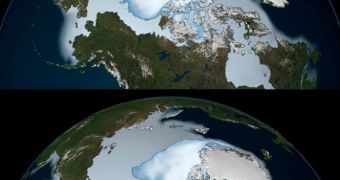A study of the Arctic recently revealed that the entire ice island is losing its perennial, multi-year ices. This is a very dangerous situation, since this particular type of ice is the most resistant to the effects of global warming. It also makes up the core of the entire Arctic.
In a paper published in the February issue of the Journal of Climate, and entitled “Large Decadal Decline of the Arctic Multiyear Ice Cover,” NASA researcher Josefino Comiso describes how the oldest ices are beginning to disappear from the North Pole.
The image to the left shows the extent of perennial ices in the Arctic in 1980 (top) and 2012. It is plainly obvious that this particular type of ice is retreating, and also that it's now only a shadow of its former self.
Climatologists say that this is a very dangerous situation. Multi-year ice freezes faster and melts slower than seasonal ices, of the type that form every winter and melt every spring. When temperatures are just right, some of the ices that form in a year endure during the next summer.
The following winter, they are again covered by new ice, which means that the ice sheet they're in grows. But this is not happening in the Arctic. Quite the contrary, in fact. As global temperatures increase, the North Pole is especially hard hit.
This means that very small amounts of ice form during winter. Therefore, when summer comes, the seasonal ice fields melt right away, exposing the perennial ice sheet underneath. The warmer atmosphere slowly chips away at these sheets.
“The oldest and thickest Arctic sea ice is disappearing at a faster rate than the younger and thinner ice at the edges of the ice cap. The rapid disappearance of older ice makes the Arctic Ocean's sea ice cap more vulnerable to further decline,” a NASA press release explains.
“Overall Arctic sea ice 'extent' – which includes all areas where at least 15 percent of the ocean surface is covered by ice – has been vanishing at a rate of –15.1 percent per decade,” the statement says.
During his study, Comiso found that perennial ices in the Arctic decline at a rate of about 12.2 percent per decade, which represents a massive difference from natural levels. At this point, there is nothing to prevent the ice from melting further.
The study author says that only a prolonged cold spell could help the formation of new multi-year ices. However, since humans appear to be unwilling to take any meaningful measures to curb global warming, that process is unlikely to be successful.

 14 DAY TRIAL //
14 DAY TRIAL //